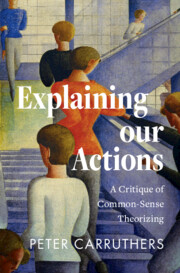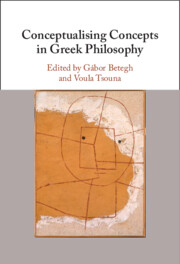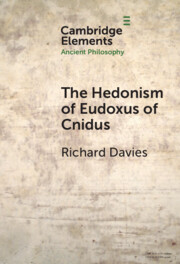Refine search
Actions for selected content:
101 results
Chapter 2 - The Heart of Happiness
- from Part I - Aquinas on Individual Happiness
-
- Book:
- Aquinas and the Ethics of Happiness
- Published online:
- 07 August 2025
- Print publication:
- 21 August 2025, pp 37-59
-
- Chapter
- Export citation
Chapter 10 - Temperance
- from Part IV - Virtues of Indirect Caring
-
- Book:
- Attention to Virtues
- Published online:
- 25 July 2025
- Print publication:
- 14 August 2025, pp 238-258
-
- Chapter
- Export citation
Felt-Quality Hedonism, Alienation, and the Spirit of Resonance
-
- Journal:
- Utilitas , First View
- Published online by Cambridge University Press:
- 07 July 2025, pp. 1-22
-
- Article
-
- You have access
- Open access
- HTML
- Export citation
Chapter 5 - Decision-Making and Goals
-
- Book:
- Explaining our Actions
- Published online:
- 17 April 2025
- Print publication:
- 08 May 2025, pp 91-113
-
- Chapter
- Export citation
Chapter 6 - Pleasure and (Affective Forms of) Desire
-
- Book:
- Explaining our Actions
- Published online:
- 17 April 2025
- Print publication:
- 08 May 2025, pp 114-134
-
- Chapter
- Export citation

Explaining our Actions
- A Critique of Common-Sense Theorizing
-
- Published online:
- 17 April 2025
- Print publication:
- 08 May 2025
Chapter Five - Prodigal Pleasures
-
- Book:
- The Politics of Immorality in Ancient Rome
- Published online:
- 28 February 2025
- Print publication:
- 06 March 2025, pp 173-206
-
- Chapter
- Export citation
Chapter 5 - Literary Plants
- from Part I - Historical Periods
-
-
- Book:
- The Cambridge Handbook of Literature and Plants
- Published online:
- 06 February 2025
- Print publication:
- 13 February 2025, pp 90-108
-
- Chapter
- Export citation
Chapter 3 - Textual Strategies
- from Part II - Reading Vivisectors
-
- Book:
- Vivisection and Late-Victorian Literary Culture
- Published online:
- 30 January 2025
- Print publication:
- 06 February 2025, pp 73-101
-
- Chapter
- Export citation
‘The Highest Epicurism’: Mary Astell’s Feminist Ethics and Late Seventeenth-Century Hedonistic Thought
- Part of
-
- Journal:
- Journal of the American Philosophical Association / Volume 11 / Issue 1 / March 2025
- Published online by Cambridge University Press:
- 09 January 2025, pp. 42-60
-
- Article
-
- You have access
- Open access
- HTML
- Export citation
A Paradox of Pleasure: Black Joy during “the Nadir,” 1875‒1905
-
- Journal:
- The Journal of the Gilded Age and Progressive Era / Volume 24 / Issue 1 / January 2025
- Published online by Cambridge University Press:
- 25 February 2025, pp. 21-37
- Print publication:
- January 2025
-
- Article
-
- You have access
- Open access
- HTML
- Export citation
CICERO AND EPICURUS ON PLEASURE AND FRIENDSHIP
-
- Journal:
- The Classical Quarterly / Volume 74 / Issue 2 / December 2024
- Published online by Cambridge University Press:
- 18 February 2025, pp. 596-610
- Print publication:
- December 2024
-
- Article
-
- You have access
- Open access
- HTML
- Export citation
Classic Hedonism Reconsidered
-
- Article
-
- You have access
- Open access
- HTML
- Export citation
30 - The Queerness of Blackness
- from Race and the Politics of Queer and Trans Representation
-
-
- Book:
- The Cambridge History of Queer American Literature
- Published online:
- 17 May 2024
- Print publication:
- 06 June 2024, pp 567-580
-
- Chapter
- Export citation
2 - Sexuality in Ancient Egypt: Pleasures, Desires, Norms, and Representations
-
-
- Book:
- The Cambridge World History of Sexualities
- Published online:
- 26 April 2024
- Print publication:
- 16 May 2024, pp 22-42
-
- Chapter
- Export citation
Chapter 9 - Epicureans on Preconceptions and Other Concepts
-
-
- Book:
- Conceptualising Concepts in Greek Philosophy
- Published online:
- 25 April 2024
- Print publication:
- 02 May 2024, pp 203-236
-
- Chapter
-
- You have access
- Open access
- HTML
- Export citation

Conceptualising Concepts in Greek Philosophy
-
- Published online:
- 25 April 2024
- Print publication:
- 02 May 2024
-
- Book
-
- You have access
- Open access
- Export citation
8 - Johann Georg Heinrich Feder
- from Part III - The Reception of the Critique of Practical Reason
-
- Book:
- Kant's <i>Critique of Practical Reason</i>
- Published online:
- 31 January 2025
- Print publication:
- 28 March 2024, pp 199-202
-
- Chapter
- Export citation

The Hedonism of Eudoxus of Cnidus
-
- Published online:
- 27 November 2023
- Print publication:
- 21 December 2023
-
- Element
- Export citation
Chapter 1 - The Varieties of Pessimism
- from Part I - Nietzsche’s Intellectual Context and Early Reception of Pessimism
-
- Book:
- Nietzsche's Struggle against Pessimism
- Published online:
- 02 November 2023
- Print publication:
- 16 November 2023, pp 21-65
-
- Chapter
- Export citation
